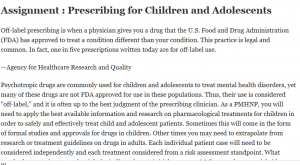Care Across the Lifespan I
Special Considerations Related to Prescribing for Children and Adolescents
There is probably no greater responsibility that the psychiatric-mental health nurse practitioner assumes than the responsibility of prescribing medications. While patients can be harmed by psychotherapy, the level and intensity of the harm generally does not approach the same level of harm that can occur from improper prescribing. PMHNPs must understand their responsibility, both at the state and federal levels, when it comes to prescribing medications.
This week, you will explore the particular clinical considerations associated with prescribing for children and adolescents.
Assignment : Prescribing for Children and Adolescents

Off-label prescribing is when a physician gives you a drug that the U.S. Food and Drug Administration (FDA) has approved to treat a condition different than your condition. This practice is legal and common. In fact, one in five prescriptions written today are for off-label use.
—Agency for Healthcare Research and Quality
Psychotropic drugs are commonly used for children and adolescents to treat mental health disorders, yet many of these drugs are not FDA approved for use in these populations. Thus, their use is considered “off-label,” and it is often up to the best judgment of the prescribing clinician. As a PMHNP, you will need to apply the best available information and research on pharmacological treatments for children in order to safely and effectively treat child and adolescent patients. Sometimes this will come in the form of formal studies and approvals for drugs in children. Other times you may need to extrapolate from research or treatment guidelines on drugs in adults. Each individual patient case will need to be considered independently and each treatment considered from a risk assessment standpoint. What psychotherapeutic approach might be indicated as an initial treatment? What are the potential side effects of a particular drug?
For this Assignment, you consider these questions and others as you explore FDA-approved (“on label”) pharmacological treatments, non-FDA-approved (“off-label”) pharmacological treatments, and nonpharmacological treatments for disorders in children and adolescents.
Reference:
Agency for Healthcare Research and Quality. (2015). Off-label drugs: What you need to know. https://www.ahrq.gov/patients-consumers/patient-involvement/off-label-drug-usage.html
To Prepare
· Your Instructor will assign a specific disorder for you to research for this Assignment. Please complete your assignment on Major Depression
· Use the Walden library to research evidence-based treatments for your assigned disorder in children and adolescents. You will need to recommend one FDA-approved drug, one off-label drug, and one nonpharmacological intervention for treating this disorder in children and adolescents.
The Assignment (1–2 pages)
· Recommend one FDA-approved drug, one off-label drug, and one nonpharmacological intervention for treating your assigned disorder in children and adolescents.
· Explain the risk assessment you would use to inform your treatment decision making. What are the risks and benefits of the FDA-approved medicine? What are the risks and benefits of the off-label drug?
· Explain whether clinical practice guidelines exist for this disorder and, if so, use them to justify your recommendations. If not, explain what information you would need to take into consideration.
· Support your reasoning with at least three scholarly resources, one each on the FDA-approved drug, the off-label, and a non-medication intervention for the disorder. Attach the PDFs of your sources.